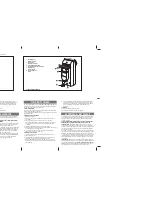
1
3
MOUNTING THE RACK
The rack is a length of steel that has nylon teeth attached to it. The rack is attached to the gate by
means of TEK screws. The rack meshes with the pinion gear on the motor which then drives the
gate.
It is very important that the rack is mounted securely and that the rack meshes with the pinion gear
for the full length of the gate . Any section of rack that is too tight or too loose will cause problems
with the operation of the gate.
Step 1
: ensure that the motor is at least
7 mm above the ground level
and that the gate is in the
closed position.
Fig A
Step 2
: place a piece of the rack on the pinion of the motor, ensuring that the teeth of the rack and
the pinion mesh correctly.
Step 3
: now fasten the rack to the gate using the TEK screws. The TEK screw should be placed in
the centre of the slot in the rack so as to allow for adjustment later.
FIG B
Step 4
: push the gate towards the open position continuing to secure the rack to the full length of
the gate. Ensure that the rack is securely meshed with the pinion at all times during this operation.
Repeat step 4 until the full length of rack is attached to the gate.
Step 5
: using the jackup bolts under the motor,
drop the motor 2mm
, this allows a slight gap be
tween the teeth of the rack and the pinion so as to prevent any binding or tight spots on the rack.
FIG C
Step 6
: push the gate all the way open and closed to check that the rack is meshing with the pinion
for the complete length of the gate.
Check that the rack is not touching the motor while running and also check that the rack covers at
least three quarters of the pinion at all times when viewed from above.
Start with 7 mm space
Drop motor by 2 mm when
rack is secured to gate.
5
m
m
2
m
m
C
Place the TEK screws as shown bellow for the
complete length of rack.
Place TEK screw here
B
7
m
m
A
IT IS RECOMMENDED THAT THE RACK
IS MOUNTED AS SHOWN AND NOT
INVERTED , AS THIS MAY CAUSE OB
STRUCTION SENSING PROBLEMS







































